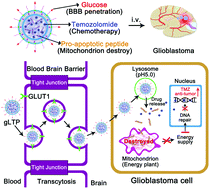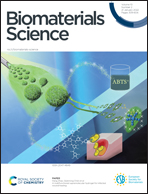Blood–brain barrier penetrating liposomes with synergistic chemotherapy for glioblastoma treatment†
Abstract
Glioblastoma multiforme (GBM) is an aggressive and malignant brain tumor with high mortality. The current treatment strategies are still unsatisfactory for this devastating disease. Here, we developed a glucose-functionalized liposome (gLTP) that co-loads temozolomide (TMZ) and pro-apoptotic peptide (PAP) to achieve synergistic efficacy towards GBM. The gLTP can readily penetrate the blood–brain barrier via the glucose–GLUT1 pathway and release the TMZ and PAP in the cells. The PAP destroys the mitochondria and subsequently depletes ATP generation, making the GBM cells more sensitive to TMZ-mediated chemotherapy. gLTP exhibits the best anti-tumor effect on the subcutaneous brain tumor model compared to other treatments, including a single drug (TMZ or PAP) liposome and TMZ and PAP physical mixture. On the highly aggressive intracranial tumor model, gLTP can readily penetrate the BBB and efficiently deliver the drugs into the brain tumor, leading to striking improvements in total survival compared to the other treatments. This strategy potentially inspires new attempts to design more effective anti-GBM formulations.



 Please wait while we load your content...
Please wait while we load your content...